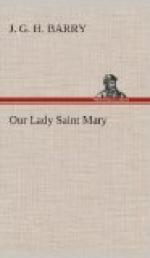S. Matt. XXVII, 59, 60.
It is meet in very truth to bless thee the Theotokos, the ever-blessed and all-immaculate and Mother of our God. Honoured above the Cherubim, incomparably more glorious than the Seraphim, thou who without stain gavest birth to God the Word, and art truly Mother of God, we magnify thee.
BYZANTINE.
The end had come—so it must have seemed to those who had loved and followed our Lord. As they came back from the burial, those of them who had remained true to the end, as they came out of their hiding places, those others who forsook Him and fled, they met in that “Upper Room” which was already consecrated by so many experiences. They came back from Joseph’s Garden, S. John leading the blessed Mother, the Magdalen and the other Mary following, S. Peter came from whatever obscure corner he had found safety in. The other Apostles came one by one, a frightened, disheartened group, shame-faced and doubtful as to what might next befall them. The thing that to us seems strangest of all is that no one seems to have taken in the meaning of our Lord’s words about His resurrection. Not even S. Mary herself appears to have seen any light through the surrounding darkness. I suppose that so much of what our Lord taught them was unintelligible until after the coming of the Holy Spirit that they rarely felt sure that they understood His meaning; and when the meaning was so unprecedented as that involved in His sayings about the resurrection we can understand that they should have been so little influenced by them.
S. Mary’s grief would have been so deep, so overwhelming, that she would have been unable to think of the future at all save as a dreary waste of pain. She could only think that her Son who was all to her, was dead. She had stood by the Cross through all the agony of His dying: she had heard His last words. That final word to her had sunk very deep into her heart. She had once more felt His Body in her arms as it was taken down from the Cross; and she had followed to the place where was a Garden and a new tomb wherein man had never yet lain, there she had seen the Body placed and hastily cared for, as much as the shortness of the time on the Passover Eve would permit. And then she had gone away, not caring at all where she was taken, with but one thought monotonously beating in her brain,—He is dead, He is dead.
It would not be possible in such moments calmly to recall what He Himself had taught about death. Death for the moment would mean what it had always meant to religious people of her time and circle. What that was we have very clearly presented to us in the talk with Martha that our Lord had near the place where Lazarus lay dead. There is a fuller knowledge than we find explicit in the Old Testament, showing a growth in the understanding of the Revelation in the years that fall between the close of the Old Testament canon and the coming of our Lord. There




